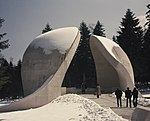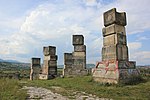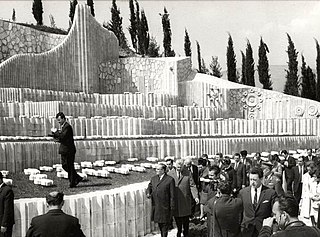List of World War II monuments and memorials in Bosnia and Herzegovina includes Yugoslav monuments and memorials build on the territory of the present day Bosnia and Herzegovina.
List of World War II monuments and memorials in Bosnia and Herzegovina includes Yugoslav monuments and memorials build on the territory of the present day Bosnia and Herzegovina.
The Yugoslav authorities established several memorial sites between 1945 and 1960, though widespread building started after the founding of the Non-Aligned Movement.
Yugoslav president Josip Broz Tito commissioned several memorial sites and monuments in the 1960s and 70s dedicated to World War II battle and concentration camp sites. They were designed by notable sculptors, including Dušan Džamonja, Vojin Bakić, Miodrag Živković, Jordan and Iskra Grabul, and architects, including Bogdan Bogdanović, Gradimir Medaković. After Tito's death, a small number were built, and the monuments were popular visitor attractions in the 1980s as patriotic sites, and since the Yugoslav Wars and the dissolution of Yugoslavia, the sites have been abandoned and have lost their importance.
The list includes monuments and memorials built between 1945 and 1991, but does not include busts or other statues of individuals (see bottom).
| Image | Name | Location | Notes |
|---|---|---|---|
 | Vraca Memorial Park | Sarajevo | Rehabilitation of old Austro-Hungarian fortress with combined work of Vladimir Dobrović as designer, Alija Kučukalić as sculptor, and Aleksandar Maltarić as landscaper, opened on 25 November 1981. |
 | Partisan cemetery in Mostar | Mostar | Designed by Bogdan Bogdanović, built in 1965. |
 | Monument to the Revolution | Kozara | Also known as the Mrakovica Memorial, dedicated to the Battle of Kozara. Designed by Dušan Džamonja. Completed in 1972. |
| Partisan Memorial, Banja Luka | Banja Luka | ||
 | Valley of heroes | Tjentište | |
 | Necropolis for the victims of Fascism | Novi Travnik | Designed by Bogdan Bogdanović, opened in 1975. |
 | Monument to the Revolution | Grmeč | Located in the Korčanica Memorial Zone of the Grmeč. |
 | Monument to the fallen Frontiersmen | Banja Luka | Dedicated to fallen frontier soldiers in the Banj hill. Designed by Antun Augustinčić. |
| Memorial cemetery in Vukosavci | Vukosavci | Designed by Drago Tršar; built in 1986. Dedicated to the fighters of Majevica partisan detachment that were killed by chetniks in 1942. | |
| Monument to Zenica Partisan Detachment | Zenica | Built in 1968. Dedicated to fallen fighters of Zenica Partisan Detachment. | |
| Monument to Husino miners | Tuzla | Designed by Ivan Sabolić. Dedicated to Husino miners fallen in the Husino uprising of 1920 and People's Liberation Struggle 1941-1945. | |
 | Eternal flame | Sarajevo | Built in 1946. Dedicated to Yugoslav army liberators of Sarajevo in 1945. |
| Monument to fallen fighters | Banja Luka | ||
 | Partisans' Cemetery | Prijedor | Burial place of National Hero Mladen Stojanović. Approximately 120 Partisan fighters buried here. |
| Monument to fallen fughters | Banja Luka | ||
| Monument to victims of fascism | Rakovačke bare | Dedicated to the mine workers killed by Ustaša on 7 February 1942. | |
 | Monument to fallen fighters and victims of fascism | Ljubačevo | Dedicated to the mine workers killed by Ustaša on 7 February 1942. |
| Memorial relief to the People's Liberation Struggle | Bihać | ||
| Djevojka sa Une | Bihać | Dedicated to soldiers of the Yugoslav Army fallen during the liberation of Bihać in 1945. | |
| Memorial ossuary of fallen fighters | Bratunac | ||
| Monument to fallen fighters and victims of fascism | Mašići | ||
| Monument to the first partisan airport | Međuvođe | ||
| Monument to victims of fascism | Bosanska Kostajnica | ||
| Monument to fallen fighters | Kotor Varoš | ||
| Monument to fallen fighters | Baraći | ||
 | Monument to fallen fighters and victims of fascism | Bosanski Novi | |
| Monument to fallen fighters | Visoko | Opened in 1963. | |
| Monument to fallen fighters | Cazin | ||
| Partisan cemetery in Livno | Near Livno | Designed by Vinko Kragic and Frano Buskareli, built in 1972. | |
 | Mass Grave | Ljeskare, Prijedor municipality | Monument erected in the 1980s to mark site of mass grave containing 13 individuals |
 | Monument to the First Partisan Pilots | Prijedor | Located beside the 'Urije' airstrip. |
 | Garavice Memorial Park | Bihać | Designed by Bogdan Bogdanović, built in 1981. Declared a National Monument of Bosnia & Herzegovina in 2011. |
| Monument in Vogošća | Vogošća | Designed by Zlatko Ugljen, built in 1969. Commemorates 62 Partisan fighters and Illegal Workers. |

Yugoslavia was a country in Southeast and Central Europe that existed from 1918 to 1992.

The Socialist Federal Republic of Yugoslavia (SFRY), commonly referred to as SFR Yugoslavia or simply as Yugoslavia, was a country in Central and Southeast Europe. It emerged in 1945, following World War II, and lasted until 1992, with the breakup of Yugoslavia occurring as a consequence of the Yugoslav Wars. Spanning an area of 255,804 square kilometres (98,766 sq mi) in the Balkans, Yugoslavia was bordered by the Adriatic Sea and Italy to the west, by Austria and Hungary to the north, by Bulgaria and Romania to the east, and by Albania and Greece to the south. It was a one-party socialist state and federation governed by the League of Communists of Yugoslavia, and had six constituent republics: Bosnia and Herzegovina, Croatia, Macedonia, Montenegro, Serbia, and Slovenia. Within Serbia was the Yugoslav capital city of Belgrade as well as two autonomous Yugoslav provinces: Kosovo and Vojvodina.

Foča is a town and a municipality located in Republika Srpska in south-eastern Bosnia and Herzegovina, on the banks of Drina river. As of 2013, the town has a population of 12,234 inhabitants, while the municipality has 18,288 inhabitants.

Jajce is a small city in Bosnia & Herzegovina, central not only geographically but also culturally. Throughout Bosnia’s long history, Jajce has been the home of medieval kings, Ottoman governors, and a range of different ethnic groups, as well as being one of President Tito’s earliest Communist strongholds. Jajce has been so far undiscovered by tourists, although UNESCO has recently been investing in renovating the city’s historical areas,Town and municipality located in the Central Bosnia Canton of the Federation of Bosnia and Herzegovina, an entity of Bosnia and Herzegovina. According to the 2013 census, the town has a population of 7,172 inhabitants, with 27,258 inhabitants in the municipality, It is situated in the region of Bosanska Krajina, on the crossroads between Banja Luka, Mrkonjić Grad and Donji Vakuf, on the confluence of the rivers Pliva and Vrbas.

The Yugoslav Partisans, or the National Liberation Army, officially the National Liberation Army and Partisan Detachments of Yugoslavia, was the communist-led anti-fascist resistance to the Axis powers in occupied Yugoslavia during World War II. Led by Josip Broz Tito, the Partisans are considered to be Europe's most effective anti-Axis resistance movement during World War II.

Croatian nationalism is nationalism that asserts the nationality of Croats and promotes the cultural unity of Croats.

The Partisan Memorial Cemetery in Mostar is located in Mostar, Bosnia and Herzegovina. It was built in 1965 in honor of the Yugoslav Partisans of Mostar who were killed during World War II in Yugoslavia. It's located on Bijeli Brijeg and displays all the features of a complex architectural, aesthetic and landscape design. It is a unique monument in the urban scale of the city of Mostar, and is of particular ambient value.

The authorities of the Socialist Federal Republic of Yugoslavia established many World War II memorials during its existence. Several memorial sites were established between 1945 and 1960, though widespread building started after the founding of the Non-Aligned Movement.

The Armijska Ratna Komanda D-0, also known as the Ark, ARK/D-0, Atomska Ratna Komanda, and nicknamed Tito's bunker, is a Cold War-era nuclear bunker and military command centre located near the town of Konjic in Bosnia and Herzegovina. Built to protect Yugoslav President Josip Broz Tito and up to 350 members of his inner circle in the event of an atomic conflict, the structure is made up of residential areas, conference rooms, offices, strategic planning rooms, and other areas. The bunker remained a state secret until after the breakup of Yugoslavia in the 1990s.

The Bridge on the Neretva is the memorial bridge on the Neretva river, in Jablanica, Bosnia and Herzegovina. Bridge is part of the Memorial of the Battle on the Neretva dedicated to the famous World War II battle, fought between Yugoslav partisans and Axis forces, as part of the 4th Enemy Offensive in February–March 1943. The battle is also known as the "Battle for the Wounded on the Neretva" or simply the "Battle for the Wounded".

Israel–Yugoslavia relations were historical foreign relations between Israel and now split-up Socialist Federal Republic of Yugoslavia. Positive initial relations between the two states were subsequently negatively affected by the Arab–Israeli conflict and close relations between Yugoslavia and some Arab states, particularly Yugoslav relations with Egypt. Despite cancelation of the formal relations after the Six-Day War informal, commercial and cultural exchanges continued throughout the Cold War period.